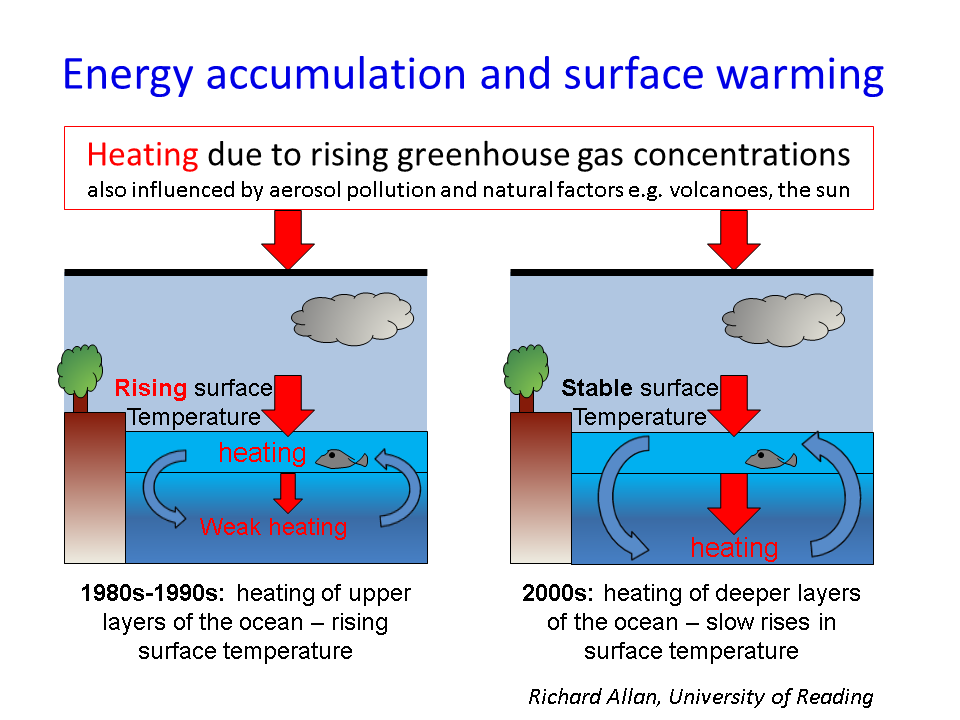July 2013:
Science Media Centre briefing on the recent slowdown in global surface temperature rise
A briefing for journalists on the causes of the recent slowdown in global surface warming was held at the Science Media Centre on Monday 22nd July 2013 (see briefing notes).
Global average temperature at the Earth's surface has not risen significantly over the last 10-15 years. Yet based upon observations, the oceans beneath the surface are continuing to warm. While small volcanic eruptions during the 2000s and a minimum in the output of the sun toward the end of that decade have counteracted slightly the heating effects from rising greenhouse gas concentrations (see slide from Piers Forster), a combination of satellite data since 2000 and thousands of automated ocean measurements down to nearly 2000m depth since around 2005 indicate that heat is continuing to accumulate (equivalent to continuous heating by over 150 billion 2 kilo-Watt kettles!). Based on detailed simulations and observations of the ocean surface temperature it is thought that natural changes in ocean circulation have caused heating from rising greenhouse gas concentrations to temporarily warm the deeper ocean (e.g. below 300m) rather than the surface layers which influence Earth's surface temperature (see cartoon below). The precise mechanisms involved are being actively researched (e.g. the NERC DEEP-C project).
 ABOVE: A cartoon depicting decades in which heating is strongest in the upper layers of the ocean (e.g. 1980s-90s) and the most recent period in which heating affects deeper layers instead, with little change in surface temperature.
ABOVE: A cartoon depicting decades in which heating is strongest in the upper layers of the ocean (e.g. 1980s-90s) and the most recent period in which heating affects deeper layers instead, with little change in surface temperature.
The detailed computer models of our atmosphere, ocean and land that are used to make projections of likely future climate change can represent the fluctuations in ocean circulations that generate decades of stable surface temperatures. They cannot capture the correct timing of these events but they suggest that generally around 2 of such decades can occur every century (see also illustration by Ed Hawkins). Therefore, while it is impossible to predict the timing of these natural fluctuations, the recent slowdown in warming is not out of the ordinary and continued heating of the oceans is consistent with the increasing levels of greenhouse gases in the atmosphere.
It is difficult to say how long the lull in surface warming will continue. One climate simulation with steadily rising CO2 concentrations produces no trend in global surface temperature over a 24 year period. Also, who's to say that an explosive volcano won't erupt over the next few decades (aerosol particles injected into the stratosphere as a result cool the planet by reflecting more sunlight back to space)? However, a return to substantial warming over the next few decades is expected; some decades of rapid warming and others with slow warming will occur as a result of natural fluctuations in the ocean.
I describe some of these aspects in an interview with the Voice of Russia's Tim Ecott. The briefing has also lead to a number of good articles, for example in the Daily Mail and the Independent (see also Telegraph, Guardian, BBC, Times, Financial Times, Herald Scotland and the Associated Press). In addition, the Met Office has developed three detailed reports on the recent pause in surface warming
Richard P. Allan Location: Department of Meteorology (2U15)